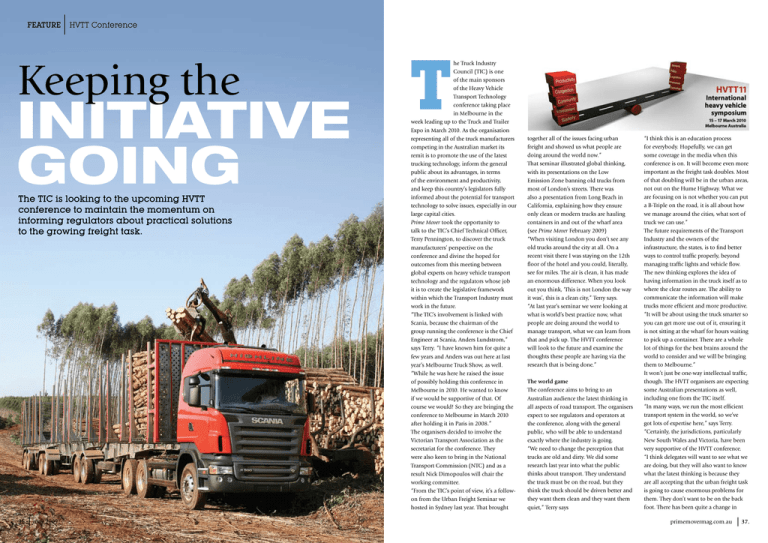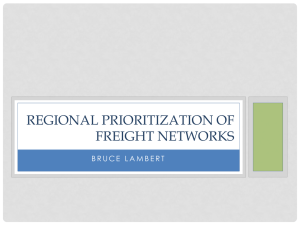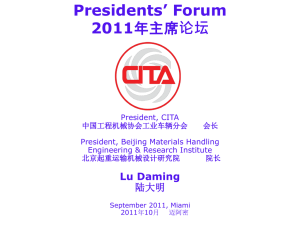Document 11385342
advertisement

feature HVTT Conference Keeping the initiative going The TIC is looking to the upcoming HVTT conference to maintain the momentum on informing regulators about practical solutions to the growing freight task. 36. may 2009 T he Truck Industry Council (TIC) is one of the main sponsors of the Heavy Vehicle Transport Technology conference taking place in Melbourne in the week leading up to the Truck and Trailer Expo in March 2010. As the organisation representing all of the truck manufacturers competing in the Australian market its remit is to promote the use of the latest trucking technology, inform the general public about its advantages, in terms of the environment and productivity, and keep this country’s legislators fully informed about the potential for transport technology to solve issues, especially in our large capital cities. Prime Mover took the opportunity to talk to the TIC’s Chief Technical Officer, Terry Pennington, to discover the truck manufacturers’ perspective on the conference and divine the hoped for outcomes from this meeting between global experts on heavy vehicle transport technology and the regulators whose job it is to create the legislative framework within which the Transport Industry must work in the future. “The TIC’s involvement is linked with Scania, because the chairman of the group running the conference is the Chief Engineer at Scania, Anders Lundstrom,” says Terry. “I have known him for quite a few years and Anders was out here at last year’s Melbourne Truck Show, as well. “While he was here he raised the issue of possibly holding this conference in Melbourne in 2010. He wanted to know if we would be supportive of that. Of course we would! So they are bringing the conference to Melbourne in March 2010 after holding it in Paris in 2008.” The organisers decided to involve the Victorian Transport Association as the secretariat for the conference. They were also keen to bring in the National Transport Commission (NTC) and as a result Nick Dimopoulos will chair the working committee. “From the TIC’s point of view, it’s a followon from the Urban Freight Seminar we hosted in Sydney last year. That brought together all of the issues facing urban freight and showed us what people are doing around the world now.” That seminar illustrated global thinking, with its presentations on the Low Emission Zone banning old trucks from most of London’s streets. There was also a presentation from Long Beach in California, explaining how they ensure only clean or modern trucks are hauling containers in and out of the wharf area (see Prime Mover February 2009) “When visiting London you don’t see any old trucks around the city at all. On a recent visit there I was staying on the 12th floor of the hotel and you could, literally, see for miles. The air is clean, it has made an enormous difference. When you look out you think, ‘This is not London the way it was’, this is a clean city,” Terry says. “At last year’s seminar we were looking at what is world’s best practice now, what people are doing around the world to manage transport, what we can learn from that and pick up. The HVTT conference will look to the future and examine the thoughts these people are having via the research that is being done.” The world game The conference aims to bring to an Australian audience the latest thinking in all aspects of road transport. The organisers expect to see regulators and operators at the conference, along with the general public, who will be able to understand exactly where the industry is going. “We need to change the perception that trucks are old and dirty. We did some research last year into what the public thinks about transport. They understand the truck must be on the road, but they think the truck should be driven better and they want them clean and they want them quiet,” Terry says “I think this is an education process for everybody. Hopefully, we can get some coverage in the media when this conference is on. It will become even more important as the freight task doubles. Most of that doubling will be in the urban areas, not out on the Hume Highway. What we are focusing on is not whether you can put a B-Triple on the road, it is all about how we manage around the cities, what sort of truck we can use.” The future requirements of the Transport Industry and the owners of the infrastructure, the states, is to find better ways to control traffic properly, beyond managing traffic lights and vehicle flow. The new thinking explores the idea of having information in the truck itself as to where the clear routes are. The ability to communicate the information will make trucks more efficient and more productive. “It will be about using the truck smarter so you can get more use out of it, ensuring it is not sitting at the wharf for hours waiting to pick up a container. There are a whole lot of things for the best brains around the world to consider and we will be bringing them to Melbourne.” It won’t just be one-way intellectual traffic, though. The HVTT organisers are expecting some Australian presentations as well, including one from the TIC itself. “In many ways, we run the most efficient transport system in the world, so we’ve got lots of expertise here,” says Terry. “Certainly, the jurisdictions, particularly New South Wales and Victoria, have been very supportive of the HVTT conference. “I think delegates will want to see what we are doing, but they will also want to know what the latest thinking is because they are all accepting that the urban freight task is going to cause enormous problems for them. They don’t want to be on the back foot. There has been quite a change in primemovermag.com.au 37. feature HVTT Conference “There are a whole lot of things for the best brains around the world to consider and we will be bringing them to Melbourne.” thinking and certainly in my discussions with certain jurisdictions they really want to define the issues and find out what people around the world are doing about them and thinking about them. What can we learn to manage our system better?” State of play Terry reckons the last 18 months have seen State Governments really think about this issue of the freight task. “I am on the New South Wales Freight Advisory Council and they have been moving heaven and earth to improve things,” he says. “Victoria is doing the same, as is Queensland. I think there is a better understanding of the size of the problem. For a while, people thought it was not that big an issue but, lately, as more and more data has become available, it has become very clear that the road freight task is going to grow enormously and be a major issue they will have to contend with. “I think they are taking the bull by the horns, they understand the size of the problem and they want to deal with it. 38. may 2009 They do understand that the infrastructure has limitations to it and they have got to use it as smart as they can. Sydney now has different tolls for different times on the Harbour Bridge to try and ease congestion. Some people don’t like it, but it is working.” Recent changes do indeed indicate the jurisdictions are thinking about things. The fact that they all attended the TIC seminar last October in reasonable numbers, with several authorities making a presentation, speaks volumes. The regulators and decision makers in the state authorities can be expected to attend the HVTT conference and some of the jurisdictions are committing to supporting it financially. The TIC continues to emphasise that it wants to work with them to get the best for road transport, getting the optimum truck fleet out on the roads. “From our point of view, we will mainly support the NTC, but the decisions are made by the states. We need to work with the states and then through the NTC to get a national approach. It is up to the states what happens on their roads. We have to work very closely with them while pushing for a national approach to things by bringing the NTC into these discussions,” Terry says. “There is nothing worse than one state having a different regulation to what everybody else has. We sell trucks to people all around the country, so it would be better for us if there were one set of national regulations. Unfortunately, you have to acknowledge the fact that Sydney is different from Melbourne and both are different from Brisbane and Perth. Regulators have to legislate as they see fit, in a way that is best for their city. “It’s our job to get that approach as uniform as we possibly can. However, at the end of the day, you have to be trying to get improvements through and if you can only get them through in one state, you start there. We work through the states because they are the final decision makers and then bring that through the NTC to try and get it as national as we possibly can.” Looking at possible changes to be considered Terry points to examples like those places in the USA where tipper trailers on road works are fitted with an extra tri-axle under the tipper, to allow trucks to carry an extra 20 tonne within the same 19 metre semi-trailer. Technically, the design is needed to get all of these axles load sharing, to allay fears of damage to the road infrastructure. “You may be limited as to where you can take these vehicles, but if you have a particular job to do and get one truck to do the work of two, it is a plus for everyone. The operator improves productivity and congestion is reduced,” he says. “The HVTT conference is a good opportunity to show people what is being done and also to show them the research that supports these changes. We can show, globally, that there has been a lot of research done on this issue and there is data to back up this work. “The regulators have to prove to the politicians that something is going to work and, of course, the politicians have to sell it to the general public. So we have to have that back-up data there. This is one of the things the conference will do.”




